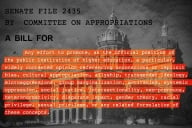You have /5 articles left.
Sign up for a free account or log in.
It's March. Conference season is in full swing. Events have been taking place since the beginning of the month. Recently, I was chatting with a friend and told him that I "had made a mistake." He asked what I had done. My response: "I went to some sessions." Oh snap! Now before I continue, I do need to make a caveat. First of all, I've been to some amazing conference sessions this month. They do exist. Unfortunately, Student Affairs sessions at most conferences are horrid. There, I said it. If I was one of your students and you were presenting to me, I would most likely fall asleep and/or find an excuse to leave the room. Your content might be amazing, but it's presented in a non-compelling way. Slide after slide with 36 bullet points, MS Word clip art, and awkward transitions.
Why in the heck do we continue to create sessions that are so poorly constructed? Late last year, I wrote about some tips for presentations. I realize that a lot of folks might have missed that post. So, here are a few more tips for giving a conference session that excites and educates:
Do not rely on the Internet.
Connectivity at a convention center or hotel is going to be unreliable. If it's your first time presenting, I understand. If you've been presenting year after year, you have no excuses. Use screenshots to share examples. "Borrow" videos off of sites like YouTube by downloading the video files to your computer. That way, you don't have to worry about whether or not your webpage or video will load/play. I've seen this so many times and it does not have to happen. Download everything to your computer. Make your presentation run without the Internet and you have eliminated one potential encounter with Murphy's law.
Stop using bullet points.
We need a conference donation jar…every time you use a bullet point, you have to donate a dollar. Slide decks that contain hundreds of words per slide, broken up by the ubiquitous bullet point, convey one simple fact: You do not care about your audience. We are at your session in part because of the description in the program book, but also because you are presenting your information. Compel us with your knowledge, wisdom, humor, creativity, and questions. Slide deck design requires time and some aesthetic considerations. Not sure what to do, pick up a copy (or two) of Nancy Duarte's books. Her stuff is a gold mine for presenters. We're lifelong learners, so let's act like it.
Get a presentation remote.
Movement helps to stifle boredom. If you stand at a podium and you're surrounded by bullet points, I'm going to need more Red Bull. Presentation remotes let you move about and engage with your audience. My personal remote of choice is the SMK-Link RemotePoint Navigator 2.4 Premium. I realize that it sounds like something that NASA invented, but trust me, it works. I've used that particular model for several years. It's built like a tank and it has a tremendous range. The laser pointer is an added bonus. However, laser pointers are to be used sparingly. Keep the focus on you. After all, you are the speaker, the presenter, the facilitator, the one leading the way.
Construct the space.
Podiums are where presentations go to die. If you can, ask for a room set-up that is friendly to humans. My preference is to have a small table near the LCD projector. That way I can see my slides and make super fast transitions without ever having to look back at the big screen. It helps to keep your focus as a speaker on your audience.
Content matters more than audio, video, or kittens.
In the latest iteration of my Student Affairs social media keynote, I have two slides that include feisty kittens. Those slides always make people laugh. However, if you take away the kittens, the audio, and the video from my slides, my content is still compelling. Presentations are part education, part entertainment. It's "edutainment." Know your content better than anyone else. People know when you know your stuff. It boggles my mind when presenters do not practice their content. If you act like this is the first time that you've presented a particular slide deck, odds are, your audience will see right through you. Make sure that you create compelling content that fits in the time allotted for your session. 3 hours of content in 45 minutes will always feel rushed. Slow and steady wins the race…and that is certainly true with presentations. It's better to prepare 20 to 30 minutes of content. That way, you have plenty of time for questions and answers. Dialog with your audience is far better than having 200 slides.
What are your tips for a successful conference presentation?
Do you tweet? Let's connect. Follow me on Twitter.








